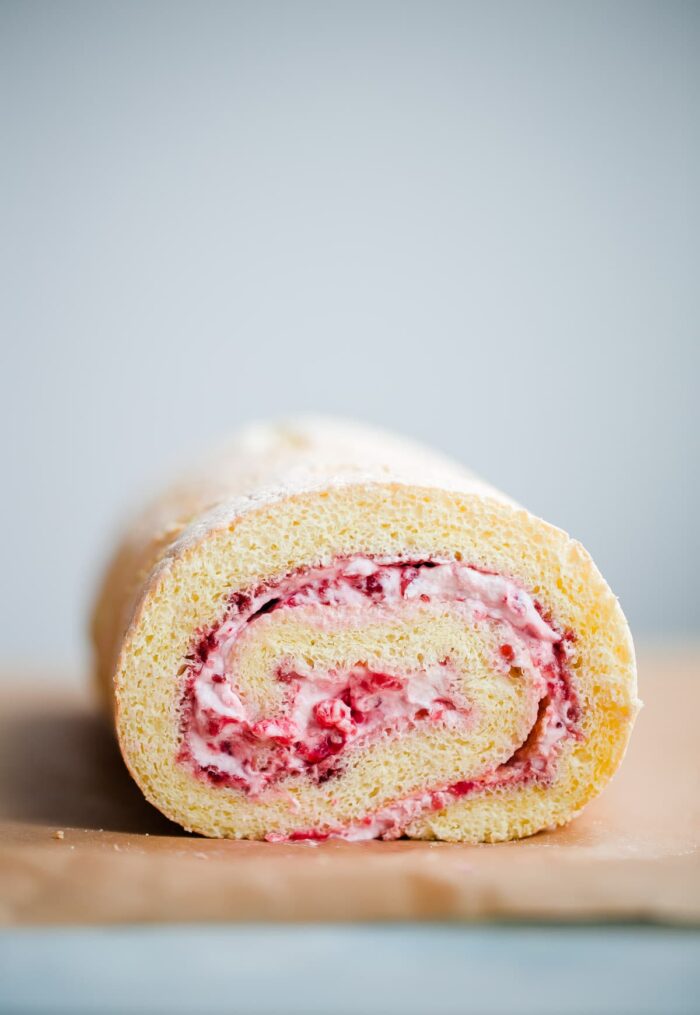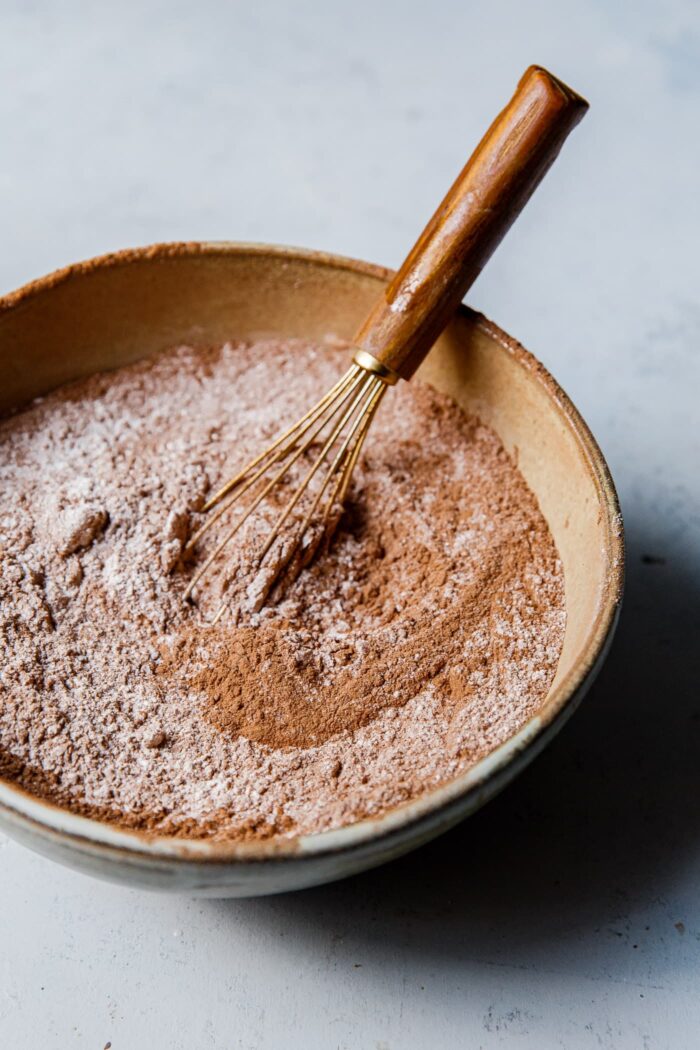Cake Flour Vs All Purpose Flour


Today we’re doing a deep dive on cake flour vs all purpose flour!
Main Difference Between Cake Flour and Purpose Flour:
The primary difference between cake flour vs all purpose flour is protein.
While protein levels can vary significantly by brand (and even batch to batch), all purpose flour is typically 10%-12% protein. In contrast, cake flour is 6%-9% protein.

How Wheat Protein (Gluten) Affects Baked Goods
Gluten is a term used to describe specific proteins (glutenins and gliadins) found in wheat. All proteins are comprised of amino acid chains.
In dry form, wheat protein has little to no structure. When combined with liquid, gluten proteins change shape and form bonds, producing tightly coiled, yet highly elastic structures. Imagine a slinky shape made up of proteins.
When this mixture is worked, stretched, or handled (eg: kneading), the proteins stretch and become even more elastic. And vice versa. This unique characteristic allows us to create airy sourdough bread, flaky pie dough, and chewy homemade pasta, among other things. Gluten and its stretching ability enables us to make thin sheets of puff pastry that don’t break or crumble during rolling.
Certain strains of wheat (eg. hard red winter wheat) are higher in protein – enabling stronger gluten bonds – than other strains (eg. soft white wheat). These strains are utilized to make different types of flours for various baking needs.
For example, bread flour vs all purpose flour will produce chewier, more lofty bread due to bread flour’s higher protein levels that offer the ability to create stronger, more elastic gluten networks.
Which leads to the following question..

What is Cake Flour?
Cake flour is generally milled from soft, low-protein wheat strains (such as ‘club wheat’). These low protein flours lend themselves to minimal gluten development or ‘strength’. This quality is disastrous for things like bread and ideal for other baked goods, such as angel food cakes, genoise or sponge cake, biscuits, and lighter-than-air muffins.
Cake flours are also milled and sifted to an extra fine texture. For this reason, they absorb liquids very quickly.
Many generic cake flour brands, such as Swan, are bleached. Others may be cut with cornstarch (check the ingredient list!). Adding cornstarch effectively dilutes the protein/gluten of the flour even more (this is the reasoning behind DIY cake flour, see substitute guide below).

Can You Substitute Cake Flour with All Purpose Flour?
If a recipe specifically calls for cake flour, I generally don’t recommend substituting it with all purpose flour unless absolutely necessary. This is particularly true for tender baked goods, such as genoise cakes, sponge roll cakes, angel food cakes, and some layer cakes.
Cake flour is low in protein, finely textured, and processed differently. Straight substitutions with all purpose flour will result in a drier, heavier crumb. White pastry flour is the next best alternative to cake flour due to its lower protein levels, but varies and can be difficult to find.
If you do wish to substitute cake flour with all purpose flour, here’s how to do it:
Cake Flour Substitute: For every cup of cake flour, use 2 tablespoons less all purpose flour and add 2 tablespoons cornstarch. Metric/Volume Equivalent: 14 tablespoons (105 grams) all purpose flour + 2 tablespoons (16 grams) cornstarch.
Why Cornstarch? Essentially this method attempts to account for the higher protein in all purpose flour by substituting a portion with cornstarch (which is naturally gluten free). This is not a true equivalent to cake flour, but can work in a pinch.

Can You Substitute All Purpose Flour with Cake Flour?
Yes! If you’re looking to hinder gluten development (minimize chew, elasticity, and extensibility) and achieve a tender, light, fine crumb, cake flour can help.
Cake and cupcakes (eg. classic vanilla cupcake or sponge cake) are good examples of recipes that may benefit from the use of cake flour.
Ingredients
Crust:
- 1 9-Inch Prebaked Quiche Crust
Filling:
- 1 large leek, white and light green parts only (200g) sliced lengthwise and thinly sliced
- 1 tablespoon (15g) unsalted butter
- 1 tablespoon (15 ml) extra virgin olive oil
- ½ teaspoon kosher salt
- 2 ounces (60g) grated Gruyère cheese
Instructions
- 1 Note: This recipe requires a 9-inch prebaked quiche crust that is on the deeper side. You can prepare this quiche using a shallow tart or pie pan, but it will most likely not accommodate the full volume of custard prepared in this recipe. You can reduce the custard (using the ratio of 1 whole egg: ½ cup cream) or leftover custard can be baked in a ramekin (to produce a crustless quiche!) at 325°F (165°C) until just set.
- 2 Preheat the oven to 325°F (165°C) with a rack in the center position. Place the prebaked quiche crust on a rimmed sheet pan and set aside.
- 3 Sauté the Leeks: In a medium skillet, heat the butter and olive oil over medium-low heat. Once the butter has melted and is lightly bubbling, add the sliced leeks and sprinkle with ½ teaspoon kosher salt. Cook, stirring often, until the leeks are soft and tender, about 10 to 12 minutes. If the pan gets dry and they are beginning to gain color, add a small splash of water as needed. Transfer to a small bowl to cool while you prepare the custard.
- 4 Prepare the Custard: In a medium bowl, combine the eggs, heavy cream, Dijon mustard, salt, and nutmeg. Whisk until smooth.
- 5Assemble and Bake: Sprinkle the grated cheese onto the bottom of the prebaked crust. Distribute the sautéed leeks in an even thin layer on top. Pour in the egg custard – it should just about reach the top. Carefully transfer to the oven and bake for 40 to 55 minutes or until lightly golden and the custard is set, but still has the slightest jiggle in the center. Set on a wire rack to cool for 10 to 15 minutes before slicing. Serve warm or at room temperature.
Ingredients
- Make this recipe your own. Swap leeks for other sautéed or roasted vegetables, such as mushrooms, broccoli, asparagus, and more. Add crispy pancetta or bacon (. Experiment with fresh herbs, such as dill, parsley, or fresh thyme. Just keep a similar volume and be sure to cook down (sauté or roast) any fresh vegetables to minimize their water content.
Substitution Notes:
- Heavy cream boasts a fat content exceeding 35%, significantly higher than whole milk’s meager 3.5% fat. This difference matters, particularly for egg custards. Opting for whole milk or a milk-cream combo is, of course, possible, but will not deliver the best texture or flavor. [Note: This is a classic French quiche, not a light frittata.] Our goal is to make an authentically classic quiche that is exceptional in taste and texture, making the effort and time invested worthwhile.





